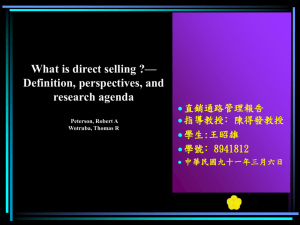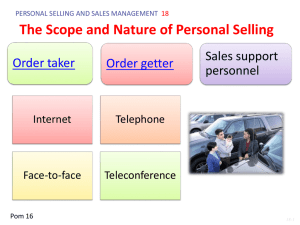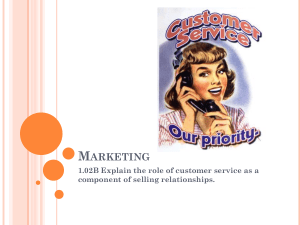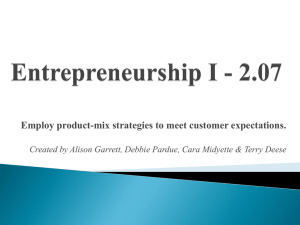chapter 16 - Prospect Learning
advertisement
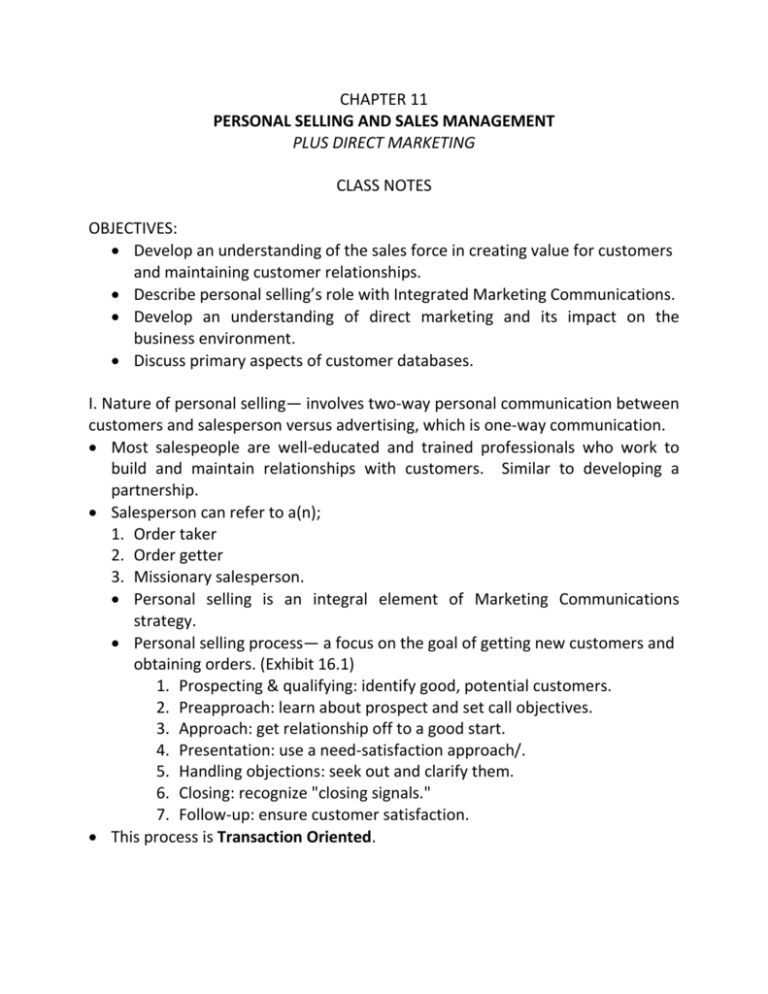
CHAPTER 11 PERSONAL SELLING AND SALES MANAGEMENT PLUS DIRECT MARKETING CLASS NOTES OBJECTIVES: Develop an understanding of the sales force in creating value for customers and maintaining customer relationships. Describe personal selling’s role with Integrated Marketing Communications. Develop an understanding of direct marketing and its impact on the business environment. Discuss primary aspects of customer databases. I. Nature of personal selling— involves two-way personal communication between customers and salesperson versus advertising, which is one-way communication. Most salespeople are well-educated and trained professionals who work to build and maintain relationships with customers. Similar to developing a partnership. Salesperson can refer to a(n); 1. Order taker 2. Order getter 3. Missionary salesperson. Personal selling is an integral element of Marketing Communications strategy. Personal selling process— a focus on the goal of getting new customers and obtaining orders. (Exhibit 16.1) 1. Prospecting & qualifying: identify good, potential customers. 2. Preapproach: learn about prospect and set call objectives. 3. Approach: get relationship off to a good start. 4. Presentation: use a need-satisfaction approach/. 5. Handling objections: seek out and clarify them. 6. Closing: recognize "closing signals." 7. Follow-up: ensure customer satisfaction. This process is Transaction Oriented. II. Managing the Sales Force 1. Designing sales force strategy & structure 2. Recruiting and selecting salespeople 3. Training sale people 4. Compensating salespeople 5. Supervising salespeople 6. Evaluating salespeople III. Role of the sales force Personal selling is effective because salespeople can: 1. Probe customers to learn more about their needs. 2. Adjust the marketing offer to fit the special requirements of each customer. 3. Negotiate terms of sales. 4. Build and maintain long-term personal relationships with key decision makers. Provides a critical link between the customers and the company. 1. Represent the company to the customers to produce a profit. 2. Represent the customers to the company to produce customer satisfaction. Relationship marketing: the whole-company process of creating, maintaining, and enhancing strong, VALUE laden relationships with customers and stakeholders. 1. Transaction is only the beginning of the relationship. 2. What is the value of a satisfied customer versus an order? IV. Public policy and ethical issues in DM Irritation, unfairness, deception, and fraud Invasion of privacy V. Direct Marketing— direct connections with carefully targeted individual consumers to obtain a direct, immediate, and measurable response as well as cultivate lasting customer relationships. It is a channel of distribution as well as an approach for communicating with consumers. Mass marketing involves one-way communications aimed at consumers. (standardized messages at broad "target" markets.) BUT Direct marketing involves two-way interactions with customers. New direct marketing model: Is it the marketing model of the new millennium? It definitely is a supplemental medium to regular marketing and business activities. Does it constitute a complete model for doing business? Forms of direct marketing: o Online marketing o Kiosk marketing o Direct-response tv o Catalog marketing o Direct-mail o Telemarketing VI. Benefits of direct marketing Buyers' benefits Convenient and comparison easy Easy & private Product access & selection Abundance of information (too much?) Interactive & immediate New reality - "consumer control" Sellers' benefits Consumer relationship building Reduces costs Increases speed & efficiency Provides flexibility (consider print catalog) Global medium VII. Customer database marketing— the process of building, maintaining, and using databases for the purposes of contacting and transacting with customers. A customer database does not equal a customer mailing list. Database can be used for: 1. Identifying good, potential prospects 2. Deciding which Right customer should receive which Right promotion at the Right time. 3. Deepening customer loyalty 4. Reactivating customer purchases.



